
CollectMax allows users to create variables for the Simple Data Extraction Reports.
From the Simple Data Extraction Templates Screen,

Click the
![]() button and select from the Menu.
button and select from the Menu.

Select Report Vars
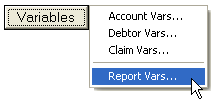
to display the Report Variable Definition Screen.
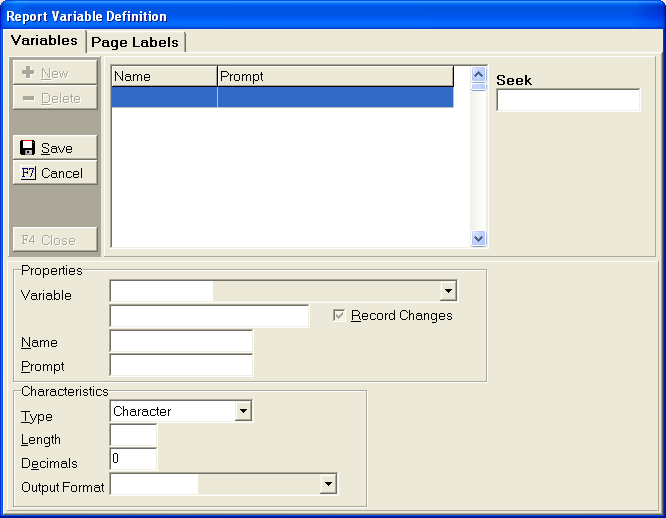
Click the
 button and select to Format An ExistingI
button and select to Format An ExistingI
![]()
Select Format Existing to take an existing variable and reformat the output/result.
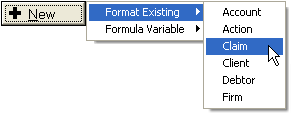
Select to categorize the formatted variable as Account, Action, Claim, Client, Debtor or Firm. The Variable Definition Screen will be displayed.

Select the
Variable to be formatted from the Variable List by clicking the ![]() button and selecting the variable.
button and selecting the variable.
Note: If formatting the Letter Date, Judgment Date or any date, you must select a variable in digits. LDATED for Letter Date and JMTDATED for Judgment Date.
Note: If formatting a debtor name, you must select DENAMEFMT - Debtor Name Formatted for every option except from Lowercase, Uppercase and Cap First. These options can be used with DENAMEL1.
Once you have selected the variable that needs formatting, skip the blank prompt where the variable name has been copied. There is no need to change this unless you need to format a specific debtor or claim balance.
For example: DENAMEFMT[2] points to the 2nd debtor on the account, DBAL[2] points specifically to the debtor balance on the 2nd claim on the account.
Fill in the
Name field with a short name or
code name of the new field (maximum of 15 characters and cannot contain
any special characters or spaces). For example "YearOnly".
This code name will be displayed in the variable  list.
list.
![]()
Fill in the
Prompt area with a longer description
of the variable (maximum of 18 characters). For example "LDATE
Year Only". This item will appear in the variable  list
for selection in placing in the document and on the document preview screen.
list
for selection in placing in the document and on the document preview screen.
![]()
In the Characteristics section, you must select Character no matter what type of variable you have chosen in the Variable line above.
![]()
In Length, fill in a maximum length for the variable. If using a numeric type, you may need to fill in Decimals with 2.
![]()
![]()
In the Output Format section, use the  arrow
to pick a format from the predefined options available.
arrow
to pick a format from the predefined options available.
![]()
Click on
the button, then click the
button, then click the  button to return
to the Simple Data Extraction Template.
button to return
to the Simple Data Extraction Template.
Select Formula Variable to create a new variable using a formula to calculate the variable value.
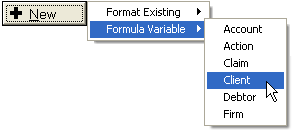
Select to categorize the formatted variable as Account, Action, Claim, Client, Debtor or Firm. The Variable Definition Screen will be displayed.
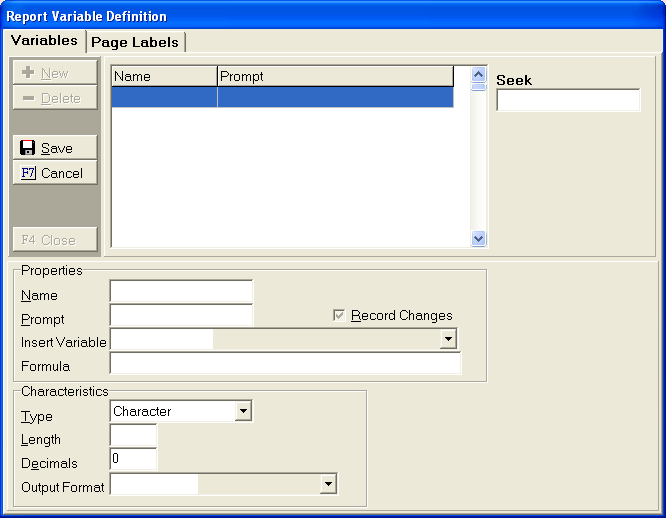
Fill in the
Name field with a short name or code name of the new field (maximum of
15 characters and cannot contain any special characters or spaces). For
example: PRINFEES.
This code name will be displayed in the variable  list.
list.
![]()
Fill in the
Prompt area with a longer description
of the variable (maximum of 18 characters). For example DPrin
+ DFees. This
item will appear in the variable  list
for selection in placing in the document and on the document preview screen.
list
for selection in placing in the document and on the document preview screen.
![]()
Next to Insert Variable, use the  list
to select one of the variables you need in the formula. When you click
on it, it should be copied to the next line labeled Formula.
Or you can just type in the variable next to Formula. Repeat process for
all variables you need in the formula.
list
to select one of the variables you need in the formula. When you click
on it, it should be copied to the next line labeled Formula.
Or you can just type in the variable next to Formula. Repeat process for
all variables you need in the formula.
Note: If using Letter Date, you must select LDATED from the  list. If using Judgment Date, you must select JMTDATED.
list. If using Judgment Date, you must select JMTDATED.
On the Formula line, insert the result operators (+ - / * ) between the variables. For example: DPRIN+DFEES. See Commonly Used Formula Variables for more examples.
In the Characteristics section, you must select Character, Numeric or Date. Numeric relates to dollar amounts, Date is for date fields, Character would be anything else.
Fill in a maximum Length for the variable. If using a numeric type, you may need to fill in Decimals with 2.
![]()
![]()
Leave the Output Format section blank or set to none.
Click on
the  button, then the
button, then the  button to return
to the Simple Data Extraction Template.
button to return
to the Simple Data Extraction Template.